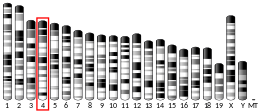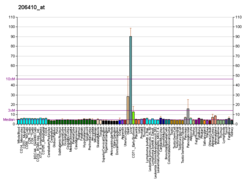호모 사피엔스 종의 단백질 코드 유전자
소형 헤테로디머 파트너(SHP)는 NR0B2(핵수용체 서브패밀리 0, 그룹 B, 멤버 2)라고도 알려져 있으며, NR0B2 [5] 단백질 이다.SHP는 세포내 전사인자 의 [6] 핵수용체 패밀리의 구성원이다. SHP는 DNA 결합 도메인이 없다는 점에서 핵 수용체로는 이례적이다. 따라서 기술적으로 전사인자도 핵수용체도 아니지만 다른 핵수용체 패밀리와의 배열 상동성이 상대적 으로 높기 때문에 여전히 전사인자로 분류된다.
기능. SHP의 주요 역할은 비생산적 헤테로디머를 [7] 단백질은 또한 대사 주기 시계의 매개 인자로 확인되었습니다. 연구 결과 단백질은 레티노이드 및 갑상선 호르몬 수용체와 상호작용하여 그들의 배위자 의존적 전사 활성화를 억제하는 것으로 나타났습니다. 또한 에스트로겐 수용체와의 상호작용이 증명되어 기능저해로 이어지고 있다. 연구에 따르면 단백질은 두 가지 단계를 통해 핵호르몬 수용체 매개 트랜스 활성화 를 억제한다. 즉, 공동활성화제와의 경쟁과 전사억제제 기능의 [5]
구조 및 배위자 EID1과의 공결정화에 의해 생성된 LBD 전용 SHP의 결정구조를 얻을 수 있다. 일반적인 AF-2 부위에 결합하는 대신, EID1은 LBD의 보통 나선형 α1 대신 채워져 SHP를 더 용해시킨다. 전체적인 구조는 다른 LBD의 apo (리간드리스) 형태와 유사합니다. 일부 합성 레티노이드 배위자는 SHP의 LBD에 결합할 수 있으며 AF-2 [9]
상호 작용 NR 문헌의 텍스트 마이닝뿐만 아니라 대규모 및 중규모 Y2H 실험은 핵 수용체 이량화 네트워크에서 SHP의 중요한 역할과 다른 NR에 비해 상대적으로 높은 연결 상태를 부각시켰다. [10]
소규모 헤테로다이머 파트너는 다음과 상호작용하는 것 으로 나타났습니다.
레퍼런스 ^ a b c GRCh38: 앙상블 릴리즈 89: ENSG00000131910 - 앙상블 , 2017년 5월^ a b c GRCm38: 앙상블 릴리즈 89: ENSMUSG000037583 - 앙상블 , 2017년 5월^ "Human PubMed Reference:" . National Center for Biotechnology Information, U.S. National Library of Medicine .^ "Mouse PubMed Reference:" . National Center for Biotechnology Information, U.S. National Library of Medicine .^ a b "Entrez Gene: NR0B2 nuclear receptor subfamily 0, group B, member 2" .^ Lee HK, Lee YK, Park SH, Kim YS, Park SH, Lee JW, et al. (June 1998). "Structure and expression of the orphan nuclear receptor SHP gene" . The Journal of Biological Chemistry . 273 (23): 14398–402. doi :10.1074/jbc.273.23.14398 PMID 9603951 . ^ Båvner A, Sanyal S, Gustafsson JA, Treuter E (December 2005). "Transcriptional corepression by SHP: molecular mechanisms and physiological consequences". Trends in Endocrinology and Metabolism . 16 (10): 478–88. doi :10.1016/j.tem.2005.10.005 . PMID 16275121 . S2CID 7884363 . ^ Wu N, Kim KH, Zhou Y, Lee JM, Kettner NM, Mamrosh JL, et al. (September 2016). "Small Heterodimer Partner (NR0B2) Coordinates Nutrient Signaling and the Circadian Clock in Mice" . Molecular Endocrinology . 30 (9): 988–95. doi :10.1210/me.2015-1295 . PMC 5004116 PMID 27427832 . ^ a b Zhi X, Zhou XE, He Y, Zechner C, Suino-Powell KM, Kliewer SA, et al. (January 2014). "Structural insights into gene repression by the orphan nuclear receptor SHP" . Proceedings of the National Academy of Sciences of the United States of America . 111 (2): 839–44. Bibcode :2014PNAS..111..839Z . doi :10.1073/pnas.1322827111 PMC 3896210 PMID 24379397 . ^ Amoutzias GD, Pichler EE, Mian N, De Graaf D, Imsiridou A, Robinson-Rechavi M, et al. (July 2007). "A protein interaction atlas for the nuclear receptors: properties and quality of a hub-based dimerisation network" . BMC Systems Biology . 1 : 34. doi :10.1186/1752-0509-1-34 . PMC 1971058 PMID 17672894 . ^ Gobinet J, Auzou G, Nicolas JC, Sultan C, Jalaguier S (December 2001). "Characterization of the interaction between androgen receptor and a new transcriptional inhibitor, SHP". Biochemistry . 40 (50): 15369–77. doi :10.1021/bi011384o . PMID 11735420 . ^ Klinge CM, Jernigan SC, Risinger KE (March 2002). "The agonist activity of tamoxifen is inhibited by the short heterodimer partner orphan nuclear receptor in human endometrial cancer cells" . Endocrinology . 143 (3): 853–67. doi :10.1210/endo.143.3.8676 PMID 11861507 . ^ a b Lee YK, Dell H, Dowhan DH, Hadzopoulou-Cladaras M, Moore DD (January 2000). "The orphan nuclear receptor SHP inhibits hepatocyte nuclear factor 4 and retinoid X receptor transactivation: two mechanisms for repression" . Molecular and Cellular Biology . 20 (1): 187–95. doi :10.1128/MCB.20.1.187-195.2000 . PMC 85074 PMID 10594021 . ^ a b c Brendel C, Schoonjans K, Botrugno OA, Treuter E, Auwerx J (September 2002). "The small heterodimer partner interacts with the liver X receptor alpha and represses its transcriptional activity" . Molecular Endocrinology . 16 (9): 2065–76. doi :10.1210/me.2001-0194 PMID 12198243 . ^ Lee YK, Moore DD (January 2002). "Dual mechanisms for repression of the monomeric orphan receptor liver receptor homologous protein-1 by the orphan small heterodimer partner" . The Journal of Biological Chemistry . 277 (4): 2463–7. doi :10.1074/jbc.M105161200 PMID 11668176 . ^ Nishizawa H, Yamagata K, Shimomura I, Takahashi M, Kuriyama H, Kishida K, et al. (January 2002). "Small heterodimer partner, an orphan nuclear receptor, augments peroxisome proliferator-activated receptor gamma transactivation" . The Journal of Biological Chemistry . 277 (2): 1586–92. doi :10.1074/jbc.M104301200 PMID 11696534 . ^ Seol W, Choi HS, Moore DD (May 1996). "An orphan nuclear hormone receptor that lacks a DNA binding domain and heterodimerizes with other receptors". Science . 272 (5266): 1336–9. Bibcode :1996Sci...272.1336S . doi :10.1126/science.272.5266.1336 . PMID 8650544 . S2CID 32853062 . ^ Seol W, Hanstein B, Brown M, Moore DD (October 1998). "Inhibition of estrogen receptor action by the orphan receptor SHP (short heterodimer partner)" . Molecular Endocrinology . 12 (10): 1551–7. doi :10.1210/me.12.10.1551 PMID 9773978 .
추가 정보 Seol W, Choi HS, Moore DD (May 1996). "An orphan nuclear hormone receptor that lacks a DNA binding domain and heterodimerizes with other receptors". Science . 272 (5266): 1336–9. Bibcode :1996Sci...272.1336S . doi :10.1126/science.272.5266.1336 . PMID 8650544 . S2CID 32853062 . Seol W, Hanstein B, Brown M, Moore DD (October 1998). "Inhibition of estrogen receptor action by the orphan receptor SHP (short heterodimer partner)" . Molecular Endocrinology . 12 (10): 1551–7. doi :10.1210/me.12.10.1551 PMID 9773978 . Lee YK, Dell H, Dowhan DH, Hadzopoulou-Cladaras M, Moore DD (January 2000). "The orphan nuclear receptor SHP inhibits hepatocyte nuclear factor 4 and retinoid X receptor transactivation: two mechanisms for repression" . Molecular and Cellular Biology . 20 (1): 187–95. doi :10.1128/MCB.20.1.187-195.2000 . PMC 85074 PMID 10594021 . Johansson L, Båvner A, Thomsen JS, Färnegårdh M, Gustafsson JA, Treuter E (February 2000). "The orphan nuclear receptor SHP utilizes conserved LXXLL-related motifs for interactions with ligand-activated estrogen receptors" . Molecular and Cellular Biology . 20 (4): 1124–33. doi :10.1128/MCB.20.4.1124-1133.2000 . PMC 85230 PMID 10648597 . Lu TT, Makishima M, Repa JJ, Schoonjans K, Kerr TA, Auwerx J, Mangelsdorf DJ (September 2000). "Molecular basis for feedback regulation of bile acid synthesis by nuclear receptors" . Molecular Cell . 6 (3): 507–15. doi :10.1016/S1097-2765(00)00050-2 PMID 11030331 . Nishigori H, Tomura H, Tonooka N, Kanamori M, Yamada S, Sho K, et al. (January 2001). "Mutations in the small heterodimer partner gene are associated with mild obesity in Japanese subjects" . Proceedings of the National Academy of Sciences of the United States of America . 98 (2): 575–80. doi :10.1073/pnas.021544398 PMC 14629 PMID 11136233 . Lee YK, Moore DD (January 2002). "Dual mechanisms for repression of the monomeric orphan receptor liver receptor homologous protein-1 by the orphan small heterodimer partner" . The Journal of Biological Chemistry . 277 (4): 2463–7. doi :10.1074/jbc.M105161200 PMID 11668176 . Nishizawa H, Yamagata K, Shimomura I, Takahashi M, Kuriyama H, Kishida K, et al. (January 2002). "Small heterodimer partner, an orphan nuclear receptor, augments peroxisome proliferator-activated receptor gamma transactivation" . The Journal of Biological Chemistry . 277 (2): 1586–92. doi :10.1074/jbc.M104301200 PMID 11696534 . Sanyal S, Kim JY, Kim HJ, Takeda J, Lee YK, Moore DD, Choi HS (January 2002). "Differential regulation of the orphan nuclear receptor small heterodimer partner (SHP) gene promoter by orphan nuclear receptor ERR isoforms" . The Journal of Biological Chemistry . 277 (3): 1739–48. doi :10.1074/jbc.M106140200 PMID 11705994 . Gobinet J, Auzou G, Nicolas JC, Sultan C, Jalaguier S (December 2001). "Characterization of the interaction between androgen receptor and a new transcriptional inhibitor, SHP". Biochemistry . 40 (50): 15369–77. doi :10.1021/bi011384o . PMID 11735420 . Klinge CM, Jernigan SC, Risinger KE (March 2002). "The agonist activity of tamoxifen is inhibited by the short heterodimer partner orphan nuclear receptor in human endometrial cancer cells" . Endocrinology . 143 (3): 853–67. doi :10.1210/endo.143.3.8676 PMID 11861507 . Ogata M, Awaji T, Iwasaki N, Miyazaki S, Bell GI, Iwamoto Y (March 2002). "Nuclear translocation of SHP and visualization of interaction with HNF-4alpha in living cells". Biochemical and Biophysical Research Communications . 292 (1): 8–12. doi :10.1006/bbrc.2002.6593 . PMID 11890664 . Cao H, Hegele RA (2002). "Identification of polymorphisms in the human SHP1 gene" . Journal of Human Genetics . 47 (8): 445–7. doi :10.1007/s100380200062 PMID 12181644 . Brendel C, Schoonjans K, Botrugno OA, Treuter E, Auwerx J (September 2002). "The small heterodimer partner interacts with the liver X receptor alpha and represses its transcriptional activity" . Molecular Endocrinology . 16 (9): 2065–76. doi :10.1210/me.2001-0194 PMID 12198243 . Borgius LJ, Steffensen KR, Gustafsson JA, Treuter E (December 2002). "Glucocorticoid signaling is perturbed by the atypical orphan receptor and corepressor SHP" . The Journal of Biological Chemistry . 277 (51): 49761–6. doi :10.1074/jbc.M205641200 PMID 12324453 . Hung CC, Farooqi IS, Ong K, Luan J, Keogh JM, Pembrey M, et al. (May 2003). "Contribution of variants in the small heterodimer partner gene to birthweight, adiposity, and insulin levels: mutational analysis and association studies in multiple populations" . Diabetes . 52 (5): 1288–91. doi :10.2337/diabetes.52.5.1288 PMID 12716767 . Lai K, Harnish DC, Evans MJ (September 2003). "Estrogen receptor alpha regulates expression of the orphan receptor small heterodimer partner" . The Journal of Biological Chemistry . 278 (38): 36418–29. doi :10.1074/jbc.M303913200 PMID 12842887 . Kovacic A, Speed CJ, Simpson ER, Clyne CD (January 2004). "Inhibition of aromatase transcription via promoter II by short heterodimer partner in human preadipocytes" . Molecular Endocrinology . 18 (1): 252–9. doi :10.1210/me.2003-0211 PMID 14593077 . 외부 링크
(1) 기본 도메인
(1.1 ) 베이직 류신 지퍼(bZIP )(1.2) 기본나선-루프-나선 (bHLH )
그룹 A 그룹 B 그룹 C bHLH-PAS 그룹 D 그룹 E 그룹 F bHLH-COE
(1.3) bHLH-ZIP (1.4) NF-1 (1.5) RF-X (1.6) 기본나선경간나선(bHSH)
(2.1) 핵수용체 (CYS4 )
서브패밀리 1 서브패밀리 2 서브 패밀리 3 서브패밀리 4 서브패밀리 5 서브패밀리 6 서브패밀리 0
(2.2) 기타 CY4 (2.3) Cys2 His2 (2.4) Cys6 (2.5) 교대 조성 (2.6) WRKY








